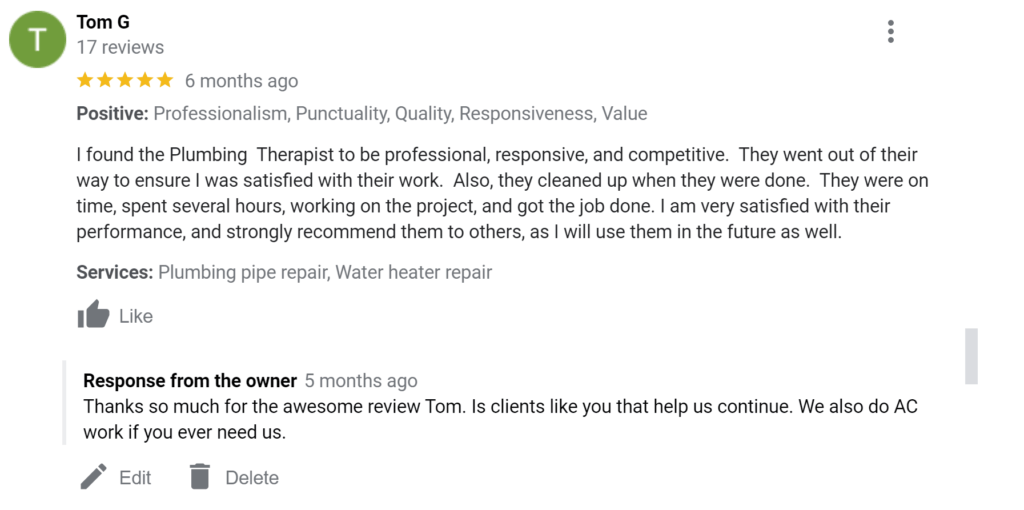Water Quality Test
Elevate your water’s purity. Tampa’s trusted Water Quality Tests by Plumbing Therapist.
Do You Need Our Help ?
Feel free to contact us now
$99 Water Heater Flush + Free Plumbing System Inspection
Water Quality Test in Tampa Bay
Plumbing Therapist's Water Quality Testing Services in Hillsborough County, Pinellas County, and Pasco County
A Water Quality Test is your gateway to understanding the health of your water supply. At Plumbing Therapist, we employ cutting-edge techniques to examine your water for impurities, contaminants, pH levels, and more. It’s a vital step in ensuring that the water you use for drinking, cooking, and daily activities is safe and pure.
Why Choose Plumbing Therapist for Your Water Quality Test?
Local Experts: We’re Tampa’s homegrown plumbing specialists, deeply familiar with the unique water challenges in our area. Our knowledge of local conditions ensures we address the specific issues that matter most to you.
Precision Testing: Our advanced testing equipment provides accurate results, giving you a clear picture of your water quality. We leave no room for uncertainty.
Comprehensive Insights: We go beyond just identifying issues. Our experts offer actionable recommendations and solutions to improve your water quality, ensuring your family’s well-being.
Transparent Service: At Plumbing Therapist, we believe in open communication. We’ll explain the results of your Water Quality Test in a way that’s easy to understand, empowering you to make informed decisions.
Customer-Centric Approach: Your satisfaction is our top priority. We work diligently to accommodate your schedule, answer your questions, and provide exceptional service from start to finish.
Licensed and Certified: Our team of professionals is fully licensed and certified, assuring you that you’re in capable hands.
Plumbing Therapist is your trusted partner in Tampa, Florida, for Water Quality Tests that leave no doubt about the purity of your water. Contact us today to schedule your test and embark on the path to cleaner, safer water in your home. Choose the best; choose Plumbing Therapist.

Why partner with Plumbing Therapist?
Quality, Affordability, and Expertise.

No Hidden or Unexpected Charges

Free Estimates & Online Booking Available

Professionally Trained Technicians

Honesty is Guaranteed

Quick Communication & Service Within 24 Hours

400+ 5 Star Reviews

The Benefits of Our Water Quality Tests
1. Healthier Living Environment: Your family’s health is paramount, and the water you use daily plays a vital role. Our Water Quality Test identifies contaminants and ensures your water is safe for drinking, bathing, and cooking, promoting a healthier living environment.
2. Purer Drinking Water: Say goodbye to concerns about the quality of the water you consume. With our testing services, you can enjoy crystal-clear, pure drinking water that tastes better and provides peace of mind.
3. Appliance Longevity: Protect your valuable appliances like water heaters and dishwashers. Clean water not only improves their performance but also extends their lifespan, saving you money on replacements and repairs.
4. Enhanced Water Quality: We don’t just detect issues; we solve them. Our Water Quality Test helps eliminate unwanted tastes, odors, and contaminants, ensuring your water is of the highest quality.
5. Prevent Plumbing Problems: Identifying corrosive elements in your water early can prevent damage to your plumbing system. Save on costly repairs and keep your pipes in optimal condition.
6. Eco-Friendly Living: Discover ways to use water more efficiently, reducing your environmental impact and contributing to a greener, more sustainable lifestyle.
7. Property Value Enhancement: If you’re considering selling your home, showcasing excellent water quality can boost its appeal to potential buyers and potentially increase its value.
8. Insurance Readiness: Some insurance claims related to water damage may require water quality testing. Ensure your water meets stringent standards to streamline any potential claims.
9. Regulatory Compliance: Stay in compliance with local and federal water quality regulations, knowing that your water is consistently safe and pure.
10. Peace of Mind: Above all, our Water Quality Test provides peace of mind. You can rest easy, knowing you’ve taken proactive steps to secure the best water quality for your family and home.
Don’t compromise on the quality of your water. Contact Plumbing Therapist today to schedule your Water Quality Test in Tampa, Florida. Our services are designed to provide you with the purest, safest water possible. Choose Plumbing Therapist for a healthier, happier home.
Unlock water quality excellence with Plumbing Therapist’s Water Quality Test services in Tampa, Florida.
If you would like more information, feel free to give them a call at (813)-437-4477 or you can book online and get their latest discount!
Customer Testimonials: Real Experiences with Plumbing Therapist
We proudly share the experiences and stories of our valued clients. Their feedback provides a glimpse into the quality of service and commitment to excellence we uphold at Plumbing Therapist. You'll read firsthand how our plumbing solutions have improved comfort and efficiency in homes across Tampa Bay. These testimonials illustrate our dedication to customer satisfaction and the difference our expert services can make.




Your questions answered
Common Water Quality Test Questions:
What are the 4 types of water quality?
The four primary types of water quality are:
Physical Water Quality: This aspect of water quality relates to the physical properties of water, including temperature, color, turbidity (clarity), taste, and odor. It focuses on the sensory and visual characteristics of water.
Chemical Water Quality: Chemical water quality assesses the presence and concentration of various chemical substances in water. This includes elements, compounds, and ions such as nutrients (e.g., nitrogen and phosphorus), heavy metals (e.g., lead and mercury), and contaminants (e.g., pesticides and pharmaceuticals).
Biological Water Quality: Biological water quality evaluates the presence and health of aquatic organisms in water bodies. It often involves monitoring indicators such as the abundance and diversity of species, as well as the presence of pathogens and bacteria that can affect human and ecosystem health.
Radiological Water Quality: Radiological water quality pertains to the presence of radioactive substances in water. This type of water quality assessment is essential for ensuring that water sources are free from harmful levels of radioactivity, which can pose health risks.
These four types of water quality assessments are crucial for evaluating the overall condition and safety of water sources, whether for drinking, recreational, or environmental purposes. They help identify potential risks and guide efforts to manage and maintain water quality.
What is pH in water?
pH in water is a measure of its acidity or alkalinity. It quantifies the concentration of hydrogen ions (H+) in the water, which determine whether the water is acidic, neutral, or alkaline (basic). The pH scale ranges from 0 to 14, with 7 being considered neutral. Here’s how pH levels are typically categorized:
Acidic: A pH value below 7 indicates that the water is acidic. Lower pH values indicate stronger acidity. Common examples of acidic substances include lemon juice (pH around 2) and vinegar (pH around 3).
Neutral: Water with a pH of 7 is considered neutral. Pure distilled water at room temperature is often used as the standard for neutrality.
Alkaline (Basic): A pH value above 7 indicates that the water is alkaline or basic. Higher pH values indicate stronger alkalinity. Common examples of alkaline substances include baking soda (pH around 9) and household ammonia (pH around 11).
pH is an important parameter in assessing water quality because it can affect various chemical and biological processes in water. For instance:
- In drinking water, a pH between 6.5 and 8.5 is typically considered safe and palatable.
- pH levels in natural bodies of water can influence the health and survival of aquatic life.
- In industrial processes, specific pH ranges may be required to optimize chemical reactions or prevent corrosion.
Maintaining appropriate pH levels in different contexts, such as drinking water treatment, agriculture, and industrial processes, is essential to ensure the safety and effectiveness of water use. pH testing is a common practice in water quality assessment and management.
Why is Water Quality Testing Important?
Water quality testing is important for several critical reasons:
Human Health: Ensuring that the water people drink is safe is paramount. Water can contain harmful contaminants and pathogens that can lead to waterborne diseases and illnesses if consumed. Regular water quality testing helps detect and mitigate these risks.
Public Health: Public water systems are required to meet strict water quality standards to protect the health of their consumers. Testing ensures that water supplied to homes and businesses complies with these regulations.
Environmental Protection: Water quality testing helps monitor and protect aquatic ecosystems. Contaminants in water bodies can harm aquatic life and disrupt fragile ecosystems. Regular testing allows for the detection and mitigation of pollution that can harm rivers, lakes, and oceans.
Drinking Water Safety: Water quality testing identifies contaminants such as heavy metals, bacteria, chemicals, and toxins that may be present in drinking water sources. Addressing these contaminants is essential for safe and clean drinking water.
Agriculture and Irrigation: Water used for irrigation in agriculture should meet specific quality standards to ensure the health of crops and to prevent contamination of food and soil.
Industrial Processes: Many industries rely on water for their processes. Ensuring that the water quality meets the required standards is essential to maintain product quality and prevent damage to equipment.
Water Treatment: Water treatment plants use water quality data to optimize treatment processes, ensuring that water leaving the treatment facility is safe and clean for distribution.
Emergency Response: In the event of a water contamination incident, water quality testing provides essential information for responding quickly and effectively to protect public health.
Regulatory Compliance: Compliance with local, state, and federal regulations is mandatory for public water suppliers. Regular water quality testing helps these suppliers meet regulatory requirements.
Awareness and Education: Water quality testing raises awareness among the public about the importance of clean and safe water. It empowers individuals and communities to take action to protect their water sources.
In summary, water quality testing is crucial because it safeguards human health, protects the environment, and ensures the safety and reliability of our water supply systems. It is an essential tool for managing and maintaining the quality of the water we use in our daily lives.
Can Water Quality Testing Detect Contaminants That Affect Taste and Odor?
Yes, water quality testing can detect contaminants that affect the taste and odor of water. Taste and odor issues in water are often caused by specific chemical compounds and substances that can be identified through testing. Here are some common contaminants that can impact the taste and odor of water and how they can be detected:
Chlorine: Chlorine is commonly used as a disinfectant in municipal water treatment. It can impart a chemical or “pool-like” taste and odor to the water. Water quality testing can measure the concentration of chlorine in the water.
Hydrogen Sulfide (H2S): Hydrogen sulfide gas in groundwater can create a distinctive “rotten egg” smell and taste. Water quality testing can detect the presence of hydrogen sulfide by measuring its concentration.
Algal Blooms: Certain types of algae in surface water sources can produce compounds that cause musty or earthy tastes and odors. Testing can identify the presence of algal toxins and the specific algae responsible.
Decaying Organic Matter: Organic matter in water can degrade over time and produce compounds that affect taste and odor. Testing can assess levels of dissolved organic carbon (DOC) and identify the source of the organic matter.
Metals: Some metals, such as iron and manganese, can create metallic tastes and odors in water when present in elevated concentrations. Water quality testing can measure metal concentrations.
Contaminants from Plumbing: Corrosion of pipes and plumbing fixtures can introduce metals and other substances into the water, affecting its taste and odor. Testing can identify these contaminants.
Water quality laboratories can conduct specific tests and analyses to determine the presence and concentration of these and other taste- and odor-causing compounds. Once identified, appropriate treatment methods can be applied to address taste and odor issues and improve the overall quality of the water supply.
How Often Should I Test My Well Water?
The frequency of testing well water depends on several factors, including local regulations, the history of water quality in your area, and specific concerns related to your well. However, here are some general guidelines for how often you should test your well water:
Annually: It is generally recommended to test your well water at least once a year for basic parameters such as bacteria (e.g., coliform bacteria) and nitrates. These tests help ensure that your water is safe to drink.
Seasonal Testing: In some cases, it may be advisable to test your well water seasonally. For example, if you live in an agricultural area where pesticides or fertilizers are used, consider testing for these contaminants during the growing season when their use is most prevalent.
After Maintenance or Repairs: Whenever you perform maintenance or repairs on your well, it’s a good practice to test the water afterward to ensure that no contaminants were introduced during the work.
Change in Water Quality: If you notice a change in the taste, odor, color, or appearance of your well water, it’s essential to conduct immediate testing to identify and address the issue.
New Wells: If you have a new well drilled, it’s essential to test the water before using it for drinking or other purposes to establish a baseline water quality profile.
Special Concerns: If you have specific concerns about your well water quality or if there have been known issues in your area (e.g., contamination from nearby sources), more frequent testing may be necessary. Consult with your local health department or a water quality professional for guidance.
Local Regulations: Be aware of any local or state regulations regarding well water testing frequency. Some areas may have specific requirements based on geographic and environmental factors.
Keep in mind that water quality can change over time, and regular testing is the best way to ensure that your well water remains safe and free from contaminants. It’s also a good idea to maintain records of your test results so that you can track any trends or changes in water quality over the years. Consulting with a local water testing laboratory or a water quality professional can provide you with specific recommendations tailored to your well and location.
What Are the Health Implications of Poor Water Quality?
Poor water quality can have significant health implications, as it can expose individuals to various contaminants and pathogens that may lead to a range of health problems. Here are some of the health implications of consuming or being exposed to water with poor quality:
Gastrointestinal Issues: Contaminated water can contain bacteria, viruses, or parasites that may cause gastrointestinal illnesses. Common symptoms include diarrhea, nausea, vomiting, abdominal cramps, and dehydration.
Waterborne Diseases: Poor water quality can be a source of waterborne diseases such as cholera, dysentery, giardiasis, and cryptosporidiosis. These diseases can be severe, especially in vulnerable populations like children and the elderly.
Respiratory Problems: Inhaling contaminated water droplets or mist, as may occur during activities like showering, can expose individuals to airborne contaminants such as Legionella bacteria. This can lead to respiratory illnesses like Legionnaires’ disease.
Skin Conditions: Certain contaminants in water can irritate the skin and cause conditions like dermatitis, eczema, or rashes. Chlorine, for example, can lead to skin and eye irritation if present in excessive amounts.
Long-Term Health Effects: Chronic exposure to certain contaminants, such as heavy metals (e.g., lead, arsenic) or persistent organic pollutants, can result in long-term health effects. These may include developmental issues in children, neurological problems, cancer, and organ damage.
Reproductive and Developmental Health: Some contaminants in water, such as endocrine-disrupting chemicals, can impact reproductive and developmental health, potentially leading to fertility issues, birth defects, and hormone-related problems.
Immunosuppression: Contaminated water can weaken the immune system, making individuals more susceptible to infections and diseases.
Exacerbation of Existing Health Conditions: Poor water quality can worsen pre-existing health conditions, particularly in individuals with compromised immune systems or chronic illnesses.
Mental Health Impact: Experiencing water-related health problems or being concerned about the safety of water can lead to stress, anxiety, and other mental health issues.
Emerging Contaminants: Emerging contaminants, such as pharmaceuticals and personal care products, may have unknown health effects when present in drinking water. Ongoing research is needed to fully understand these risks.
It’s crucial to note that the health impact of poor water quality can vary depending on the specific contaminants present, their concentrations, and the duration of exposure. To mitigate health risks associated with water quality, it is essential to ensure that drinking water meets established safety standards and that appropriate treatment and testing measures are in place. Public water suppliers are required to monitor and treat water to meet these standards, but private well owners should also take proactive steps to safeguard their water quality.

